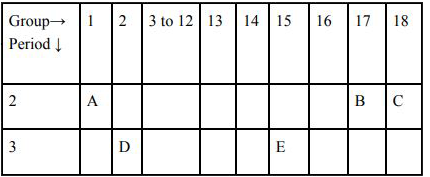Consider the following elements :
20A,8B,18C,16D,4E,2F
Answer the following giving reasons :
Which of the given elements is (are) called noble gas?
To determine which of the given elements are noble gases, we need to analyze their atomic numbers and electronic configurations.
1. Identify the elements and their atomic numbers:
- A: Atomic number 20
- B: Atomic number 8
- C: Atomic number 18
- D: Atomic number 16
- E: Atomic number 4
- F: Atomic number 2
2. Determine the electronic configurations:
- Element A (20): 1s² 2s² 2p⁶ 3s² 3p⁶ 4s² (total 20 electrons)
- Element B (8): 1s² 2s² 2p⁴ (total 8 electrons)
- Element C (18): 1s² 2s² 2p⁶ 3s² 3p⁶ (total 18 electrons)
- Element D (16): 1s² 2s² 2p⁶ 3s² 3p⁴ (total 16 electrons)
- Element E (4): 1s² 2s² (total 4 electrons)
- Element F (2): 1s² (total 2 electrons)
3. Identify noble gases:
- Noble gases are elements that have a complete outer shell of electrons, making them stable and unreactive. The noble gases are found in Group 18 of the periodic table.
- The noble gases include Helium (He, atomic number 2), Neon (Ne, atomic number 10), Argon (Ar, atomic number 18), Krypton (Kr, atomic number 36), Xenon (Xe, atomic number 54), and Radon (Rn, atomic number 86).
4. Analyze the electronic configurations:
- Element F (2): 1s² (Helium) - Noble gas
- Element C (18): 1s² 2s² 2p⁶ 3s² 3p⁶ (Argon) - Noble gas
- The other elements (A, B, D, E) do not have fully filled outer shells.
5. Conclusion:
- The elements that are noble gases from the given list are F (Helium) and C (Argon).
- A: Atomic number 20
- B: Atomic number 8
- C: Atomic number 18
- D: Atomic number 16
- E: Atomic number 4
- F: Atomic number 2
- Element A (20): 1s² 2s² 2p⁶ 3s² 3p⁶ 4s² (total 20 electrons)
- Element B (8): 1s² 2s² 2p⁴ (total 8 electrons)
- Element C (18): 1s² 2s² 2p⁶ 3s² 3p⁶ (total 18 electrons)
- Element D (16): 1s² 2s² 2p⁶ 3s² 3p⁴ (total 16 electrons)
- Element E (4): 1s² 2s² (total 4 electrons)
- Element F (2): 1s² (total 2 electrons)
- Noble gases are elements that have a complete outer shell of electrons, making them stable and unreactive. The noble gases are found in Group 18 of the periodic table.
- The noble gases include Helium (He, atomic number 2), Neon (Ne, atomic number 10), Argon (Ar, atomic number 18), Krypton (Kr, atomic number 36), Xenon (Xe, atomic number 54), and Radon (Rn, atomic number 86).
- Element F (2): 1s² (Helium) - Noble gas
- Element C (18): 1s² 2s² 2p⁶ 3s² 3p⁶ (Argon) - Noble gas
- The other elements (A, B, D, E) do not have fully filled outer shells.
- The elements that are noble gases from the given list are F (Helium) and C (Argon).
Topper's Solved these Questions
- BOOK - MTG IIT JEE FOUNDATIONCHAPTER - FOOTSTEPS TOWARDS CBSE BOARDEXERCISE - SECTION - B34videos
FOOTSTEPS TOWARDS CBSE BOARD
- BOOK - MTG IIT JEE FOUNDATIONCHAPTER - FOOTSTEPS TOWARDS (JEE MAIN) EXERCISE - Integer/Numerical Value Type5videos
FOOTSTEPS TOWARDS (JEE MAIN)
- BOOK - MTG IIT JEE FOUNDATIONCHAPTER - METALS AND NON METALS EXERCISE - Olympiad/HOTS Corner20videos
METALS AND NON METALS
Similar Questions
Consider the following elements :
20A,8B,18C,16D,4E,2F
Answer the following giving reasons :
Which of the above elements you would expect to be
in group 16 of the periodic table?View SolutionConsider the following elements :
20A,8B,18C,16D,4E,2F
Answer the following giving reasons :
Which of the above elements you would expect to be
in group 2 of the periodic table.View SolutionConsider the following elements :
20A,8B,18C,16D,4E,2F
Answer the following giving reasons :
Which of the above elements you would expect to be
very stableView SolutionConsider the following elements :
20A,8B,18C,16D,4E,2F
Answer the following giving reasons :
Which of the above elements you would expect to be
(i) very stable.
(ii) in Group 2 of the Periodic Table.
(iii) in Group 16 of the Periodic Table.
(iv) What type of bond will be formed when the element A reacts with B? Explain.View SolutionConsider the following elements :
20A,8B,18C,16D,4E,2F
Answer the following giving reasons :
What type of bond will be formed when the element A reacts with B? Explain.View SolutionConsider the following elements,
20Ca,8O,18Ar,16S,4Be,2He
Which of the above elements would you expect to be:
(i) very stable? (ii) in group 2 of the periodic table?
(iii) in group 16 of the periodic table?View SolutionFrom the following elements:
4Be,9F,19K,20Ca
(i) Select the element having one electron in the outermost shell.
(ii) Two elements of the same group. Write the formula and mention the nature the compound formed by the union of 19K and element X (2,8, 7).View SolutionThe following table shows the position of five elements A, B, C, D and E in the modern periodic table.

Answer the following giving reasons:
(i) Which element is a metal with valency two?
(ii) Which element is least reactive?
(iii) Out of D and E which element has a smaller atomic radius?View SolutionConsider the elements of period 2 in the modern periodic table. Answer the following questions with explanation.
Which is the most electropositive element in this period?View SolutionThe electron distribtution of the elements represented by the letters. A, B, C and D are so follows :
A→ 2,8,2 C → 2,8,8
B → 2,7 D → 2,8,8,2
Now , answer the following:
(i) which one of the elements belongs to the 2nd period ?
(ii) Name the elements which belong to the same group.
(iii) Which of the elements is a noble gas ?
(iv) Which of the elements are metals ?
(v) What type of bond is likely to be formed when B and D combine ?View Solution

